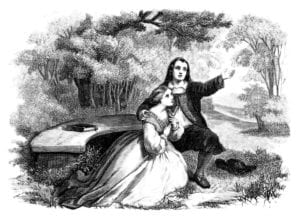Prisons were a routine part of life in Shakespeare’s experience. Playwrighting was a dangerous business in a society at war (as Shakespeare’s was with Spain) under a government as sensitive to criticism as Elizabeth’s. Many of his theatrical contemporaries – Marlowe, for example, and Thomas Kyd – could write about prisons from personal experience, and even Shakespeare himself sailed close to the wind on occasion – for example his inadvertent association with the Earl of Essex’s rebellion in 1601.
Moreover a number of his extended family and social circle also saw the inside of a prison cell. Shakespeare was raised in the aftermath of the Protestant Reformation in a recusant family in a town with enduring loyalties to the old order. His father is said to have retained his attachment to the old faith; his schoolmasters seem to have been drawn to Catholicism at University and to have acted on their ideals as adults; and members of his mother’s extended family the Ardens were closely involved in the Catholic-inspired Gunpowder Plot of 1605.
So in writing about prisons, he knew whereof he spake, and given the intense judicial heat many of his companions felt from the authorities, it is little wonder that prisons loom large in his plays – perhaps the second most familiar building after castles (or maybe taverns) in all of Shakespeare’s plays.
They feature prominently in both Histories and Comedies. Predictably perhaps, the Tower of London has a central role. It’s the location for the assassination of Henry VI at the hands of Richard Duke of Gloucester, the future Richard III. Fresh from murdering Henry’s son, he now turns his attention to Henry. The former King prophesies “much more slaughter after this”, and in the last play of the tetralogy, “Richard III”, he is proved right.
Richard clearly favours the Tower as a destination for his enemies since he makes use of it twice in the play that bears his name. First he engineers the murder of his brother George Duke of Clarence, who, soon after his arrival, is joined by murderers who, with some misgivings, complete their work. The previous night, Clarence had “dreamt that I had broken from the Tower”, but no such luck. Then, when Prince Edward arrives in London to ascend the throne, he is met by his uncle, who has arranged for him to be accommodated in the Tower. He tells his uncle “I do not like the Tower”, but he accepts the arrangement. He does not appear after 3.1, except as a ghost.
These macabre scenes, all written in around 1592, are revisited in “Richard II” (c. 1596). The former King has been deposed and sequestered in Pomfret (or Pontefract) Castle in Yorkshire. In 5.5, he is first attacked by a servant, wielding an axe, though he fights off this assault and kills the assailant. A second servant is killed, before Sir Pierce of Exton dispatches the former King. Job done he heads south to announce that Richard is dead.
If prisons are a staple ingredient of Shakespeare’s History plays, they also appear routinely in his Comedies. Here, though, there is greater variety. For example, in “The Two Gentlemen of Verona”, the Duke of Milan believes his daughter Silvia is in love with Valentine, so because he wants her to marry Thurio, he locks her in a tower and keeps the key to himself. Valentine tells his friend Proteus that he means to liberate her (Act 2 Scene 4), information that the untrustworthy Proteus conveys to the Duke, who captures and banishes Valentine.
This is one kind of prison, and it has echoes in “The Merchant of Venice”, when Shylock tells his daughter Jessica to lock herself in the house when he goes out for the evening. She follows his instructions but escapes regardless (2.5, line 875). A rather different domestic incarceration occurs in “Twelfth Night”: Malvolio is acting strangely and the decision is taken to confine him to a “dark room” (3.4). In a later scene (4.2) Feste visits him disguised as a clergyman, and gaslights him into believing that the room is not dark at all but “hath bay windows transparent”. Malvolio eventually escapes to issue his challenge – “I’ll be revenged on the whole pack of you” (5.1).
If “Measure for Measure” can be described as a Comedy, then it bears a mention here. Claudio is jailed for indulging in pre-marital sex with his intended, Juliet. He is to be executed shortly but Angelo, Vienna’s temporary governor, is deceived into believing the punishment has been carried out when the head of a quite different prisoner, a pirate, is sent to him as evidence of Claudio’s execution. Much of the play is set in the grim surrounds of Claudio’s prison, reflecting the punitive nature of Vienna’s legal code.
The contemporary view is that “Measure for Measure” is a Problem Play, and in that case it bears comparison with “The Winter’s Tale” (c.1611), another text in which a visit to prison is on the itinerary. Hermione is the prisoner, the King’s wife incarcerated because he questions whether he’s responsible for her pregnancy. She delivers her daughter in her cell, a metaphor the estimable Paulina cannot resist: “This child was prisoner to the womb”, she observes, “and is / By law and process of great nature thence / Freed”. Given the frequency with which Shakespeare associates the prison cell with death, it’s engaging to see the connection challenged. Or as the Old Shepherd says later in the play, “thou mettest with things dying, / I with things newborn”.
Surprisingly, maybe, the Tragedies make fewer visits to the prison cell – perhaps because a visit to the mortuary might be more appropriate. Nonetheless there is still room at the end of Lear for the old King’s thoughts to turn to images of the cell, where, reunited with Cordelia “In a wall’d prison”, there’ll be a chance to reminisce and gossip (“who’s in, who’s out”). The affecting speech is repudiated by Edmund: “Take them away”.
Finally, in the closing scene of “Othello”, there’s a suggestion of a prison cell awaiting Iago, when Gratiano instructs Cassio, the new governor of the isle, to decide on “the censure of this hellish villain; / The time, the place, the torture”. Among many other accomplishments, the Elizabethans were exceptionally capable torturers – plenty of practice, after all – and one imagines that Iago’s well-deserved punishment will prove a challenge.
In the scene that describes his murder, Richard II alone in his cell reflects on the nature of his imprisonment. What he feels is a mixture of boredom and fear underwritten by loneliness: “I have been studying”, he says, “how I may compare / This prison where I live unto the world: / And for because the world is populous, / And here is not a creature but myself, / I cannot do it”. Shakespeare’s works famously study the individual above all else, and their isolation is at its most vivid in prison cells: think of Malvolio, the butt of everyone else’s amusement, or Henry VI, bereft of his murdered son, his exiled wife, his crown and his humanity. In all this, Shakespeare is writing from his imagination, but as mentioned above, there were many in his circle of friends and family with first-hand experience.




